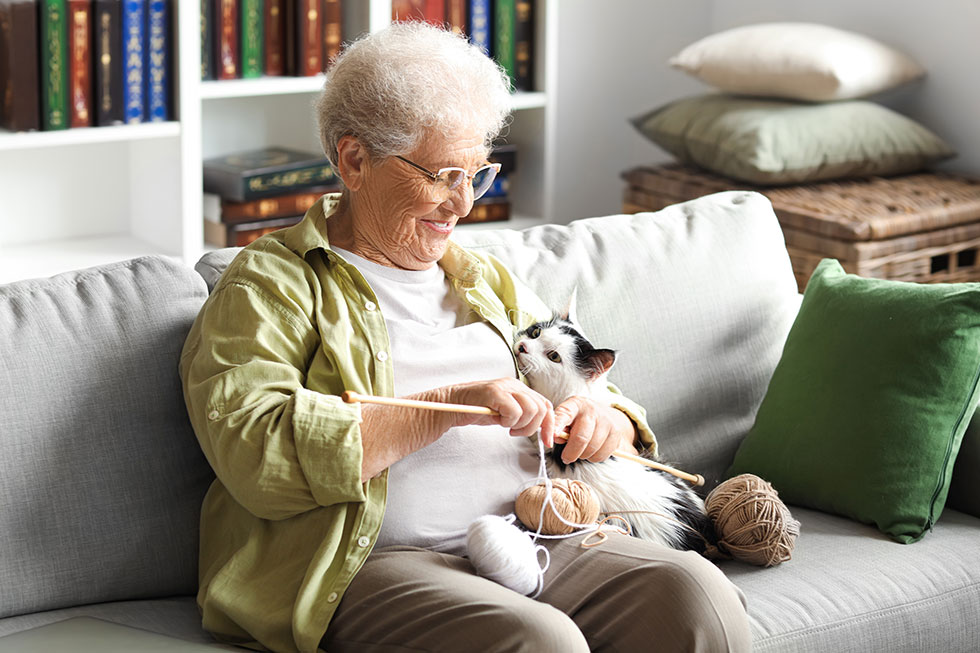“Aging in place” isn’t a new concept, but it’s become more popular than ever. An April 2024 U.S. News & World Report survey found 95 percent of adults aged 55+ consider aging in place an important goal.
Aging in place refers to the ability of seniors to live independently in their own homes and communities as they grow older.
There are both benefits and challenges to aging in place. Families can support their loved ones by proactively addressing issues such as the need for home modifications and providing reliable in-home care to help loved ones achieve their goal of aging in place successfully.

Understanding Aging in Place
Aging in place emphasizes independence and comfort in a familiar environment and allows seniors to maintain control of their personal space and engage in the daily routines and connections with the community that are familiar to them.
Living at home can boost quality of life for seniors by reducing the stress and anxiety that contribute to cognitive decline.
Aging in place also can be cost-effective compared to the expenses associated with assisted living or nursing homes.
Challenges of Aging in Place
Safety and health are two important concerns for seniors who choose to age in place. Homes may need modifications to accommodate physical limitations and prevent accidents.
Cognitive decline may necessitate additional support, and healthcare accessibility can also be a significant hurdle if frequent medical visits or specialized treatments are required.
Maintaining the home and providing personal care can become difficult, impacting the overall sustainability of aging in place.
Support Systems for Aging in Place
Seniors who choose to age in place need various layers of support, including the help of family and friends, professional in-home assistance and community resources.
Family and Friends as Caregivers
Family and friends often provide the initial support for seniors who are aging in place. This help can include assisting with daily tasks such as cooking, cleaning and running errands.
Emotional support from loved ones is important to reducing feelings of loneliness and anxiety. Regular visits and phone calls can make a significant difference.
Caregiving can be demanding, so it is essential for families to share the responsibilities, ensuring that no one person is overwhelmed. This also allows for more consistent and reliable care for the senior.
Many families turn to professional in-home care providers that offer respite care services to alleviate some of the burden placed on family members. (Read more about respite care in the blog Respite Care Offers a Break for Family Caregivers.)
Professional In-Home Assistance
If family members are unable to provide needed care, many families hire the services of an in-home healthcare provider. Some of the services these professionals provide include:
- Keeping the home environment safe to prevent falls and other mishaps
- Assistance with meal planning and preparation, light housekeeping, laundry, errands, medication reminders and escorting to appointments
- Companionship and engaging in hobbies and activities
- Supervision for someone with dementia or Alzheimer’s disease
- Medication management and basic healthcare tasks
- Assistance with self-care, including bathing and dressing
In-home healthcare providers work closely with family members to create a care plan tailored to the senior’s health needs.
Leveraging Community Resources
Community resources play a vital role in supporting seniors who wish to age in place. Local organizations such as the Area Agency on Aging offer various services, including meal delivery and transportation.
Social activities organized by community centers can help seniors stay engaged and active. Participation in these activities can prevent isolation and promote mental well-being.
Volunteering opportunities can provide a sense of purpose. Seniors can both receive support and give back to the community, fostering a reciprocal relationship that benefits all parties involved.
Adapting Homes and Lifestyles
Making homes safer and integrating technology can be a big help to seniors aging in place.
Practical modifications in the home include:
- Grab bars in the bathroom and near stairs to help prevent falls and a shower chair for stability during bathing
- Widening doorways to allow easier access for wheelchairs or walkers
- Adding ramps for those who find steps difficult
- Ensuring good lighting, especially in hallways and staircases, to minimize tripping hazards
- Modifying the bathroom with non-slip mats and adjustable showerheads
Help from Technology
Today there are many devices and apps that can assist seniors who live at home. They include:
- Medical alert systems that allow you to call for emergency help. Many include wearable devices that can detect falls and other emergency situations.
- Medication reminders can help seniors manage their prescriptions, reducing the risk of missed doses
- Smart home devices such as automated lights or thermostats
- Health monitoring technology, such as blood pressure monitors and glucose sensors, ensures health metrics are tracked accurately
- Service-related apps, such as grocery, prescription and meal delivery apps
For the 77 million people who will reach age 65 and over in the next 10 years the good news is there is an increasing number of resources that will allow them to enjoy their senior years at home safely and independently. Visit the National Institute on Aging for a wealth of information to help your loved one age in place.
